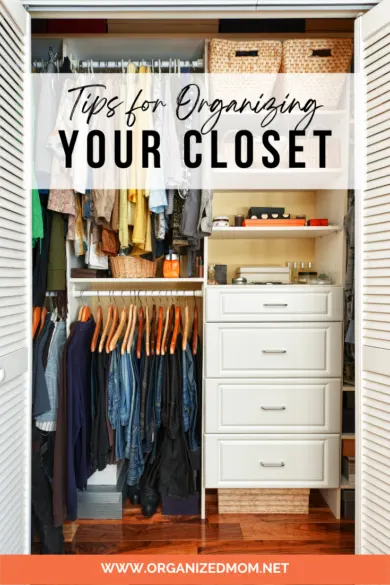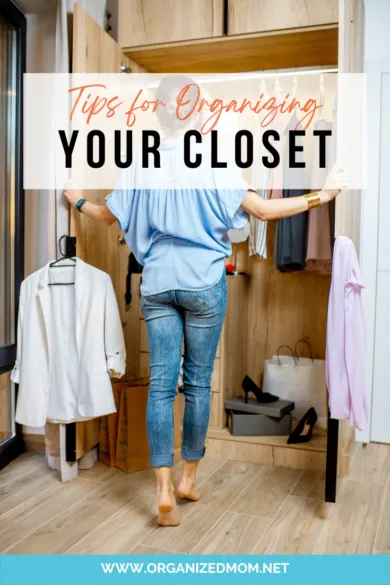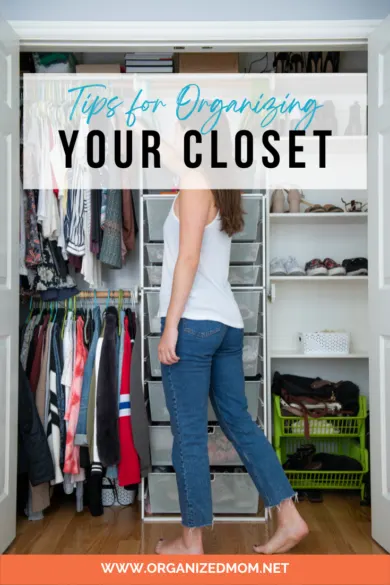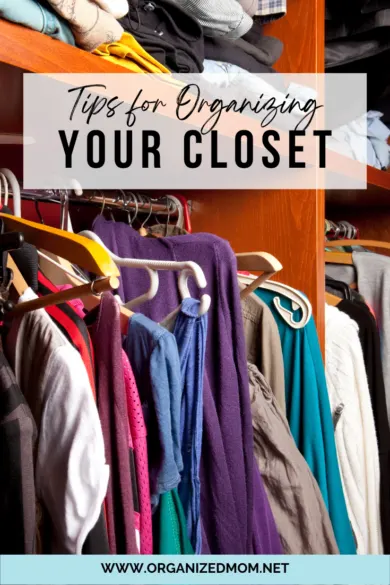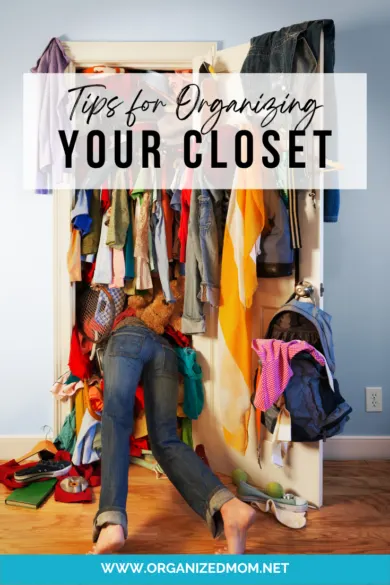When it comes to maintaining a tidy and organized home, my closet is often an area that can quickly become cluttered and chaotic.
A disorganized closet not only makes it difficult for me to find the items but it also leads to feelings of stress and overwhelm.By taking the time to organize any closet, it will create a more functionol living space.
In this blog post, I will share tips and strategies that I use to organize a closet and the benefits of having a clutter-free and organized closet.
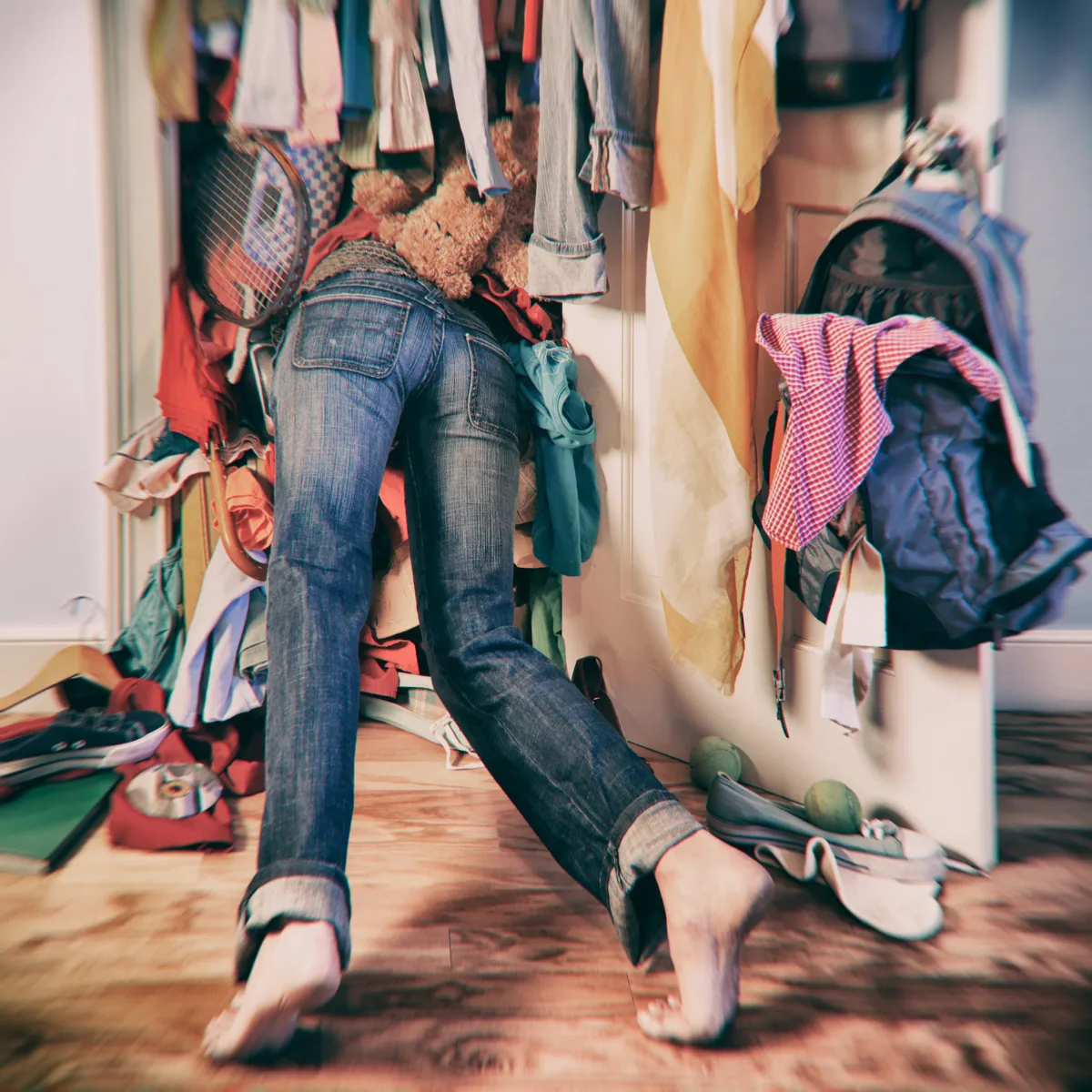
Keep only the clothes you wear regularly
The first step to getting your closet organized is to decide what clothes you really need. Don’t keep things you haven’t worn in a year or more.
You can donate these items or recycle them if they are still in good condition. If you’re selling your clothes online, make sure they’re washed and ready to go before listing them.
Decide what you want your closet to be
Before you start, take stock of your space limitations. Consider the size and shape of your closet, and clear out any items that don’t fit there.
Then consider your storage needs: if you have a lot of sweaters or coats that need to be hung up, it would be wise to invest in some hanging rods or shelving units. If most of what you want to store is folded clothing, then a standard shelf unit will probably suffice.
Finally, think about how much money you are willing to spend. You can make DIY modifications for cheap but if cash flow isn’t an issue for you then by all means go wild with your closet project!
If you’re selling your clothes online, make sure they’re clean and ready to go before you list them
It’s important to clean the clothes you’re planning on selling online. A lot of people may not know this, but if you’re going to be listing something on eBay or another online marketplace, it’s best to have it cleaned and ready for sale before putting it up.
When someone is looking at your clothing item, they want to see that it’s in a good condition. That means no stains or rips in the material and nothing falling apart at the seams (unless that’s part of its design). You can tell if something is dirty because when you hold it up close to your face, there will be visible dirt marks on the fabric – especially around where someone might wear their belt!
If you need help remembering how to properly wash clothes without damaging them or making them shrink, check out our guide here: [link].
Use garment bags to preserve your special outfits
Garment bags are a great way to store and protect your clothes. They can be used for both special outfits or everyday clothes, so it’s important to make sure you have enough in your closet!
- If you have a garment bag that’s too large for what you need, cut out the bottom and create an opening at the top of the bag. This will allow air circulation and prevent mold from forming on your clothing inside of the bag.
- Make sure when storing your garments in a garment bag that they have plenty of room to breathe; otherwise, they may get wrinkled or damaged from being crushed together in one small space.
Hang a variety of items on one hanger
You’ve probably seen this tip before, but it’s worth repeating: use garment bags to hang your clothes on hangers. Garment bags prevent creases and make it easier to find what you’re looking for. They also help preserve the shape of your clothing so that it looks great even after being hung up for a long period of time.
If hanging all your clothes by type is too much organization for you (and I wouldn’t blame you), try using hangers with multiple hooks instead.
This way, instead of having one hanger per item, like in the example above, there will be one hanger per type of clothing (that means two different types). This is especially helpful if some pieces are similar but not exactly alike—it’s easy enough to tell them apart when they’re right next to each other!

Special care for special items
Special items deserve special care. While you may not have a wedding dress or prom dress hanging in your closet, if you’ve been saving your favorite coat for years, or have an expensive piece of clothing that’s too precious to wear often but is worth keeping, these are all things worth considering.
All special items should be kept in acid-free tissue paper and placed in a garment bag. Garment bags aren’t just for formalwear: they keep dust off any piece of clothing so it will look good when it comes time to wear it again (or even sell). Special care should also be taken with storage space; cool and dry conditions are ideal for storing delicate fabrics and fine craftsmanship.
If you do have something very valuable—like a wedding dress—it’s worth looking into insurance options so that if the worst happens and your garment gets damaged beyond repair (fire damage is common), you’ll be able to replace it without breaking the bank!
Sort through your clothes and get rid of things that no longer fit or have seen better days
As you sort, keep in mind that your closet should be organized by style, color and type. You will also want to consider seasonality when organizing. For example, the following are good organizers:
- Sturdy hangers with clips or ties
- Plastic bins that fit into drawers or shelves (make sure they’re labeled!)
- Baskets with handles that can hang on the inside of a door
As you sort, be sure to evaluate each item as you go along. This part is important because it helps you weed out those items that no longer fit or have seen better days. If an item fits but isn’t current with what is currently trending in your wardrobe, get rid of it! You may be surprised by how many clothes still have their tags on them because they were never worn once purchased; these are prime candidates for donation as well! If an item is too worn out to donate but still has life left in it (the fabric hasn’t faded), consider selling it through sites like eBay or Craigslist so someone else has the opportunity to wear it—and maybe pay more than what you paid originally.
Organizing items by style, color, type and season helps you see what you have more easily
Organizing your closet by style, color, type and season makes it easier to see what you have.I
If you like wearing dresses and blouses at the same time (say in spring), then group them together so that when you’re looking for a spring outfit or some color during a cold winter day, they’ll be easy to find.
Consider what storage solutions will work for you
If you don’t want to spend money on a closet system, consider using bookshelves and other organizing components you already own. Bookshelves can be quite useful as they give you additional space for storing items that would otherwise take up valuable floor space. You can also use them for clothing storage if your closet doesn’t have enough space for it all.
If you have a lot of unused wall space and/or open flooring in your closet, consider installing multiple shelves so that you can maximize the amount of available storage space.
Store Open Shoes Openly
- If possible, remove your shoes from their boxes and store them in an open space in your closet where they can breathe. If you don’t have the room to do this, try removing the lid of the box and storing it flat so that air can circulate around your shoes.
- Store your shoes in a shoe bag or box if you want them to stay dust-free or when they’re not being worn. This will also help keep the laces straight so that when you pull out a pair to wear and put one on, there’s no fumbling around trying to get the laces untangled—you’ll just grab a pair of socks instead.
You may also want to consider using a shoe rack or shelf for storing multiple pairs in one compact space (and getting rid of some other stuff). For example: I used my old bookshelf/nightstand as an awesome place for my wife’s heels. We had two shelves installed next door with two small drawers each–one at waist level for her purses and another one above it for our watches!
Fold Items Properly
Fold items such as sweaters, jeans and pajamas so that you can see all of the items at once. This will help save space in your closet and make it more organized. Here’s how to fold different types of clothing:
Sweaters
Fold sweaters in half or thirds. If they’re too big to fit on the shelf, try folding them into fourths instead. You may also want to store them on hangers with a skirt or pair of slacks underneath; this will prevent damage if something spills onto them while in storage.
Pajamas
Fold pajamas into fourths horizontally before storing them vertically between hangers on an open shelf or inside an empty drawer (depending on their size).
Donate Away
- Anything you haven’t worn in a year should go.
- If something doesn’t fit and you have no hope of it ever fitting, donate it. (If you’re between sizes, keep the larger one—it’s not as good to wear when it’s too big, but it’s better than throwing away.
- If you don’t like an item anymore or have a lot of similar things, donate one of them.
- Donate any multiple.! It’s easy to fall into the trap of buying multiples thinking that if one gets damaged or stained, there will be another one around for backup—but that rarely happens in real life and those extras just take up space!
Create Accessory Spaces
You can use a container, shelf or hook to keep your accessories organized and easy to access. If you’re not wearing them, put them away!
- A scarf organizer is an easy way to keep long scarves in one place. It’s also nice because it prevents the fabric from wrinkling during storage (and trust me—that’s important).
- A tie rack keeps your ties organized so they don’t fall off their hangers when you’re reaching for something else in your closet. This is especially helpful if you have more than one hanger full of ties!
- A belt organizer allows one piece of cloth that often gets tossed around at the bottom of a drawer or box into its own designated spot on a shelf where it’ll stay put until next time you need it again
There are many options for creating a functional closet space on any budget
There are many options for creating a functional closet space on any budget. If you’re unsure of how much to spend, consider making do with what you have (or can easily find) around the house.
For example, if you don’t want to consider the cost of a closet system, consider using bookshelves and other organizing components you already own. Also, when possible, remove your shoes from their boxes and store them in an open space in your closet where they can breathe.
When storing shoes in boxes, be sure not to stack them high; this could cause them to get crushed or be difficult to remove later.
Bottom Line
So there you have it. Organizing your closet can be a daunting task, but the benefits of having a well-organized space are worth all the work. If you follow these tips, you’ll find yourself with an organized closet in no time at all.
